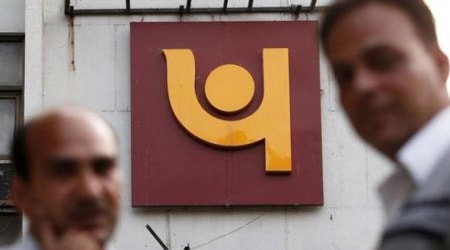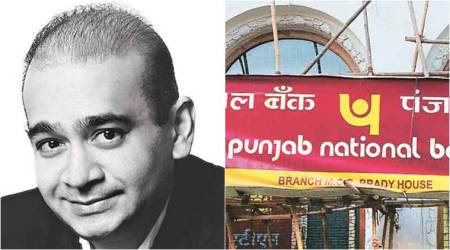 According to the 2016 report of Bains, one of the world’s top business consulting firms, India maintained its dominance in diamond cutting and polishing sector with close to 90 per cent import of rough diamonds and maintaining a 3 per cent year on year growth. (Representational Image)
According to the 2016 report of Bains, one of the world’s top business consulting firms, India maintained its dominance in diamond cutting and polishing sector with close to 90 per cent import of rough diamonds and maintaining a 3 per cent year on year growth. (Representational Image)
Atop the glass facade building of Fire Star Diamonds at Surat Special Economic Zone, the Tricolour flutters amid a scorching sun. But the long shadow of the multi-crore Punjab National Bank (PNB) fraud allegedly carried out by the owners of the company — Nirav Modi and Mehul Choksi — is hard to miss. The office is locked and an eerie silence pervades the entire premises, occasionally broken by the sound of the passing trains. Eight security guards man the main gate, and no other soul is seen on the premises.
A month ago, the place looked very different. It was bustling with activity as hundreds of workers, working in shifts, moved in and out of the premises. The two factory units owned by Modi and Choksi at the SEZ, employed around 1,300 people.
On February 16, when a team of Enforcement Directorate (ED) raided the premises, the employees were told to go home and take the day off.
Among them were 35-year-old Raju Singh and his 30-year-old wife Sunita. Both worked in the design department of the jewellery unit and together earned Rs 45,000 per month.
“It was Friday. When we turned up at the factory in the morning, we were told by our supervisor to go home as holiday has been declared. We reached home and after lunch when we switched on the television, we learnt that our factory has been sealed. We had been hearing all these years that our firm was owned by Nirav Modi, and now for the first time in the last six years, we saw him on television. I inquired with other employees of our firm, and they were also shocked on hearing the news of government raids on our firm,” says Singh, seated in his room in the Paligam area of city.
Six years ago, Singh had come to Surat from his village in Uttar Pradesh looking for a job. With the help of people from his villages who had migrated to Surat before him, he got a job in the diamond unit of the factory inside the SEZ. A year later, he married Sunita and the couple settled down in the city.
Both used to reach the factory at 9 am and worked till 6.30 in the evening. “Our dealing was with the manager and supervisor. The company had opened our bank accounts and on the 27th of every month, our salary used to be credited in our bank accounts. Till date, there has never even been a delay in getting our salaries,” he says, adding that all the artisans working at the factory were in the company’s rolls and were covered under medical insurance and provident fund.

“Not a single employee of the company would speak out against the management or an employee,” says Sunita as she points out how few months ago, the company had opened their email accounts set up a creche for children of the workers, since “35 per cent of workforce were women”.
According to Singh, working as an artisan in a diamond factory in a special economic zone has better pay structures as compared to other companies. According to him, the basic salaries start at Rs 8,000 a month and could go up to a maximum Rs 35,000 a month, depending on the kind of work and skills of the artisan. “The factory was like our mother as we were given all facilities, from lunch in the afternoon to tea,” says Singh. But now both Singh and his wife are worried.
“We have no news on whether the company will start again. Our managers sent us text messages, instructing us to be patient, and that we would be told through SMS when the company will restart,” says Singh.
So far, nobody has heard of anything.
“We are hoping and praying that the company will reopen soon, but it would take some time. At present, we are using our savings to run our houses, but my husband and his friends are looking for jobs in other companies. Some of them have even taken home loans and have to pay their instalments,” says Sunita, as she frequently look at her muted television for any update on the Nirav Modi-Mehul Choksi breaking news.
“We have kept our fingers crossed,” her husband adds.
********
Surat emerged as the largest hub among the world’s diamond processing centres in the 1990s when the economic liberalisation followed by a liberal special economic zone policy catapulted it on the map of global diamond map.
At present, there are around 5,000 small and big diamond factories in Surat city which employ between 6 lakh to 7 lakh people, who are either involved in cutting, polishing and processing rough diamonds or in its trade. According to Surat Diamond Association, out of 15 polished diamonds found in the world, 14 are cut and polished in Surat city.
According to the 2016 report of Bains, one of the world’s top business consulting firms, India maintained its dominance in diamond cutting and polishing sector with close to 90 per cent import of rough diamonds and maintaining a 3 per cent year on year growth. China, the distant second, with its diamond processing centres at Guangdong and Shanghai imported less than 10 per cent and witnessed a 14 per cent decline.
The diamond merchants of Surat have manufacturing units in the city, while trading offices in Mumbai, Hong Kong, the US, Gulf countries, Europe, including Antwerp in Belgium, which is the global hub of trading of rough as well as polished diamonds across the world.
As per the Gems and Jewellery Export Promotion Council (GJEPC), the total exports of polished diamonds and jewellery with precious stones is over Rs. 2.10 lakh crores per year.
“There are many diamond merchants and manufacturers in Surat whose firms are listed as sight holders in De Beers Company that have offices in London and Antwerp and deals with supply of rough diamonds. The company has its own diamond mines across the world and buy rough diamonds from private miners and sells it to its sight holders. The rough diamonds gets cut and polished and studded in jewellery here in Surat and later it is exported to jewellers across the world,” says Govind Dholakia owner of Shree Ram Krishna Exports, in Surat and a sight holder of De Beers Company.
Apart from the textile industry, diamond processing factories and trading centres dot this south Gujarat city. While the diamond processing units are located at Varachha, Katargam Ved Road areas on Surat, the trading activities are mostly concentrated in Varachha’s Mini Hira Bazaar, Choksi Bazaar and Mahidharpura Hira Bazaar.
The diamond and jewellery industry is mostly dominated by Jains of Banaskantha and Patels of Saurashtra. Earlier, the Jain community held sway in trading activities, while Patels dominated manufacturing. “The Patels have now also entered into the trading sector, and today both the communities have equal say in the trading of diamond,” Dinesh Navadia, chairperson of the Gujarat region of Gems and Jewellery Export Council (GJEPC), says.
According to Praveen Nanavati, former president of Surat Diamond Association, Jains, who had started zari industry, based themselves in Singapore where they discovered the diamond polishing units. “Seeing an opportunity in it, they decided to set up diamond units in Surat. They sent some of their youths for learning cutting and polishing in Singapore and started diamond industry in Surat. The reason Surat was chosen for it was because it could be reached through ships. Slowly the Jains controlled the trading activities of diamond and jewellery in Surat,” says Nanavati.
Both Choksi and Modi belong to Jain community.
Patels, according to him, were traditionally into farming, but migrated from Saurashtra to Surat because of water scarcity. “The migration began in 1960s, when the Patels started working in diamond factories. They worked hard and learnt the art of cutting and polishing, identifying the diamonds and later they jumped into trading. Now, they are leading exporters of diamond studded jewellery across the world. There are many diamond merchants who are Patels, and they run offices and outlets in different countries across the globe, including the USA, the Gulf countries, Europe, China, Hong Kong etc,” Nanavati adds.
********
Since the multi-crore rupees bank fraud, allegedly carried out by Nirav Modi and Mehul Choksi, came to light in the middle of February, Surat has witnessed a slew of raids and seizures. Till date, the investigating agencies — Enforcement Directorate (ED), Central Bureau of Investigation (CBI) and Directorate of Revenue Intelligence (DRI) — have carried out raids at at least eight locations— six factories and two offices of Gitanjali Gems and Fire Star Diamonds — belonging to the uncle-nephew duo in and around Surat. More raids were carried out at Modi’s sister concern units, Stellar Diamonds, Solar exports and RUS exports.
Sources said that officials seized loose and diamond-studded gold jewellery along with precious stones, valued around Rs 900 crores from the three premises of the two companies in Surat.
While the nation fathomed the extent of bank fraud, the shocked diamond traders in Surat grappled for its outcome.
“After this fraud, the banks will now become strict in disbursing loans to diamond jewellery manufacturers. We have come to know that some nationalised banks have started preparing to collect the outstanding dues from big diamond companies, and bank officials will be more cautious before giving away loans to us in the coming days,” says 60-year-old diamond trader Kirti Shah.
“The Nirav Modi case has shocked the diamond and jewellery industry. Those who are into large export-oriented business have to take loan from banks. While the Nirav Modi incident may not impact smaller players, but might impact those whose volumes have large and have taken loans from banks,” he adds as he look outside from his trading office at Mahidharpura diamond market.
Shah, who has 36 years of experience in diamond trade, however, feels that Nirav Modi being “a highly influential person” may go scot free. “I feel that he will manage to come out from this situation,” he says.
Dinesh Navadia, chairman of GJEPC (Gujarat Region), echoes Shah. “Till now, in last few days, we have not come across any negative impact of the Nirav Modi incident on Surat’s diamond industry,” he says repeating that banks will become stricter in giving loans to jewellery businessmen.
“Nirav Modi is a big fish and he does business on a very large scale. But those who are genuine would face no problems. Nirav Modi’s name and his firm’s image was respectable in the diamond and jewellery business and everybody was shocked after this incident,” he adds.
For all the latest India News, download Indian Express App























